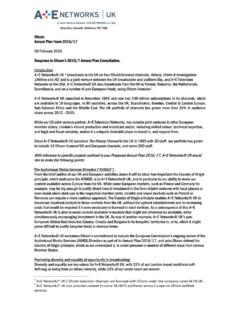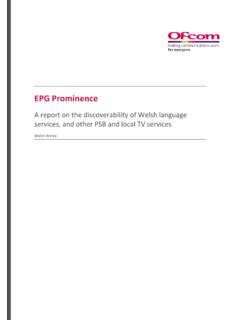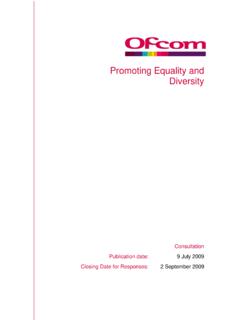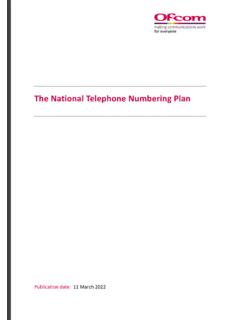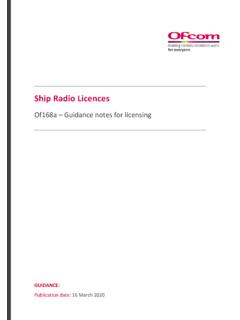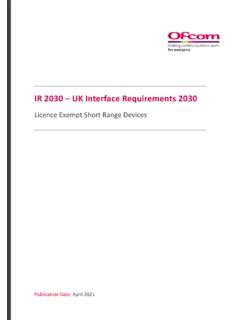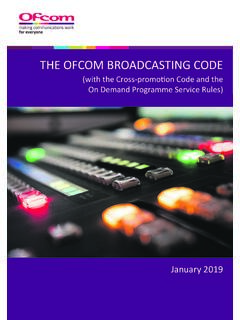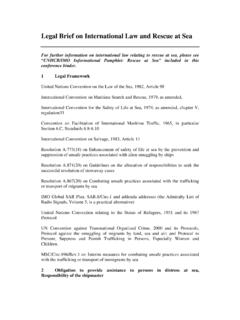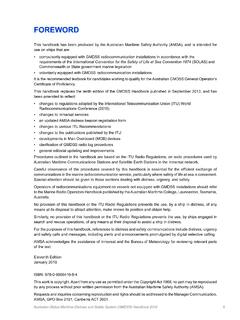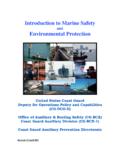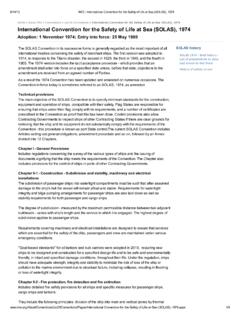Transcription of Frequencies for distress and safety, search and rescue and ...
1 Frequencies for distress and safety, search and rescue and emergencies in the UK UK Frequency Allocation Table Publication Date: 19 November 2021 Introduction Frequencies for distress and Safety, search and rescue and Emergencies Given the global nature of travel with the potential risk of accidents the international community has agreed that the use of certain Frequencies be harmonised globally for distress and safety, search and rescues and emergency use. Collectively, these are referred to as search and rescue or SAR . The International Telecommunication Union (ITU) publishes the global rules detailing which Frequencies are to be used for SAR. distress communication includes all messages relating to immediate assistance required by persons, aircraft, or marine craft in distress , including medical assistance.
2 It may also include SAR communications and on-scene communications by the rescue services. distress calls take absolute priority over all other transmissions; anyone receiving a distress call must immediately cease any transmissions that may interfere with the call and listen on the frequency used for the call. Some distress Frequencies may be used to call other stations to establish contact, whereupon the stations move to another frequency. Such channels are known as distress , safety and calling Frequencies . The object of SAR communications is to facilitate SAR operations. Such communications must allow for: rapid transmission of distress messages from aircraft, ships and small craft, including for medical assistance; rapid communication of distress information to the authorities responsible for organising and effecting rescue ; coordination of the operation of the various SAR units; liaison between controlling/coordinating authorities and SAR units; and UK organisation of search and rescue The organisation for search and rescue (SAR) in the United Kingdom of Great Britain and Northern Ireland (UK) is an amalgam of separate Government Departments, the Emergency Services and a number of search and rescue charities and voluntary organisations.
3 The UK organisation for civil maritime and civil aeronautical search and rescue is derived from the UK Government's adherence a number of international Conventions. Responsibility for the overall provision of national civil aeronautical and maritime SAR and its policies rests with the Department for Transport (DfT) through its Aviation Airspace Division (AAD) and maritime and Coastguard Agency (MCA). Further information on the organisation of search and rescue in the UK can be found on the maritime and Coastguard Agency website. Ofcom is responsible for the management of UK spectrum and the authorisation of Frequencies for non-Crown users. Table of search and rescue (SAR) frequency allocations Frequencies Use 490 kHz Transmission by coast stations or meteorological and navigational warnings and urgent information to ships by means of narrow-band direct-printing (NBDP) telegraphy (national NAVTEX service).
4 518 kHz Transmission by coast stations of meteorological and navigational warnings and urgent information to ships by means of narrow-band direct-printing telegraphy (International NAVTEX service). kHz International Global maritime distress and Safety System (GMDSS) distress frequency for narrow-band direct-printing telegraphy. 2182 kHz International distress carrier frequency for radiotelephony. distress calls and traffic, signals of emergency position-indicating radio-beacons (EPIRBs), urgency signal and urgency messages and the safety signal. GMDSS distress and safety traffic by radiotelephony. search and rescue (SAR) operations concerning manned space vehicles. kHz GMDSS distress and safety calls using digital selective calling (DSC). 2226 kHz Transmission of maritime safety information (MSI), 3 Day weather forecast.
5 2 59 6 k H z Carrier frequency for radiotelephony. Used in the UK for SAR purposes by HM Coastguard (HMCG) and the Royal National Lifeboat Institution (RNLI). 3023 kHz Aeronautical carrier frequency for radio-telephony. Can also be used in co-ordinated SAR operations. SAR operations concerning manned space vehicles. 3500 - 3800 kHz Amateur Radio band for use in the event of natural disasters, may be used by non-Amateur stations to meet the needs of international communications in the disaster area. 4125 kHz Carrier frequency used to supplement 2 182 kHz for distress and safety. GMDSS distress and safety traffic by radiotelephony. May be used by aircraft to communicate with stations of the maritime Mobile service for distress and safety purposes, including SAR.
6 Frequencies Use kHz GMDSS distress and safety traffic by NBDP. kHz GMDSS distress and safety calls using DSC. kHz National NAVTEX service transmissions by coast stations by means of NBDP. 4210 kHz Transmission by coast stations of maritime Safety Information (MSI) by means of NBDP. 5680 kHz Aeronautical carrier frequency for radiotelephony. Used in co-ordinated SAR operations. SAR operations concerning manned space vehicles. 6215 kHz Carrier frequency used to supplement 2 182 kHz for distress and safety. GMDSS distress and safety traffic by radiotelephony. 6268 kHz GMDSS distress and safety traffic by NBDP. 6312 kHz GMDSS distress and safety calls using DSC. 6314 kHz Transmission by coast stations of MSI by means of NBDP. 6425 kHz Transmission by coast stations of MSI by means of NBDP 7000 - 7200 kHz Amateur Radio band for use in the event of natural disasters, may be used by non-Amateur stations to meet the needs of international communications in the disaster area.
7 8291 kHz Carrier frequency for GMDSS distress and safety traffic by radiotelephony. 8364 kHz Used by survival craft in SAR operations with stations of the maritime and Aeronautical Mobile services. kHz GMDSS distress and safety traffic by NBDP. kHz GMDSS distress and safety calls using DSC. Frequencies Use kHz Transmission by coast stations of MSI by means of NBDP. 10003 kHz SAR operations concerning manned space vehicles. 10100 - 10150 kHz Amateur Radio band for use in the event of natural disasters, may be used by non-Amateur stations to meet the needs of international communications in the disaster area. 12290 kHz Carrier frequency for GMDSS distress and safety traffic by radiotelephony. 12520 kHz GMDSS distress and safety traffic by NBDP. 12577 kHz GMDSS distress and safety calls using DSC.
8 12579 kHz Transmission by coast stations of MSI by means of NBDP. 14000 - 14350 kHz Amateur Radio band for use in the event of natural disasters, may be used by non-Amateur stations to meet the needs of international communications in the disaster area. 14993 kHz SAR operations concerning manned space vehicles. 16420 kHz Carrier frequency for GMDSS distress and safety traffic by radiotelephony. 16695 kHz GMDSS distress and safety traffic by NBDP. kHz GMDSS distress and safety calls using DSC. kHz Transmission by coast stations of MSI by means of NBDP. 18068 - 18168 kHz Amateur Radio band for use in the event of natural disasters, may be used by non-Amateur stations to meet the needs of international communications in the disaster area. kHz Transmission by coast stations of MSI by means of NBDP.
9 19993 kHz SAR operations concerning manned space vehicles. Frequencies Use 21000 - 21450 kHz Amateur Radio band for use in the event of natural disasters, may be used by non-Amateur stations to meet the needs of international communications in the disaster area. 22376 kHz Transmission by coast stations of MSI by means of NBDP. 24890 - 24990 kHz Amateur Radio band for use in the event of natural disasters, may be used by non-Amateur stations to meet the needs of international communications in the disaster area. kHz Transmission by coast stations of MSI by means of NBDP. - MHz UK - Land search & rescue . MHz Aeronautical emergency frequency for the purposes of distress and urgency for radiotelephony by stations of the Aeronautical Mobile service.
10 May also be used for these purposes by survival craft stations. EPIRBs may also use this frequency. SAR operations concerning manned space vehicles. MHz Auxiliary to 121 5 MHz, for use by stations of the Aeronautical Mobile service and by other mobile and land stations engaged in co-ordinated SAR operations. MHz SAR helicopter co-ordination and counter-pollution operations. 144 - 146 MHz Amateur Radio band for use in the event of natural disasters, may be used by non-Amateur stations to meet the needs of international communications in the disaster area. - MHz MCA for Land SAR management - MHz Land search & rescue Scotland only. - MHz MCA for SAR management - MHz MCA for Land SAR management MHz HMCG SAR on the UK coast. Frequencies Use c/w MHz MCA for maritime Safety Information.

